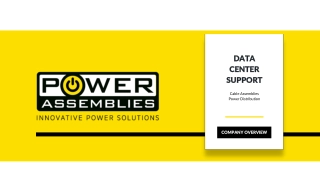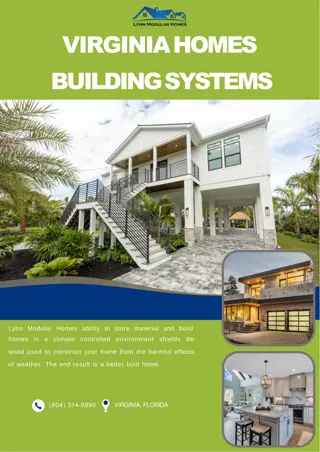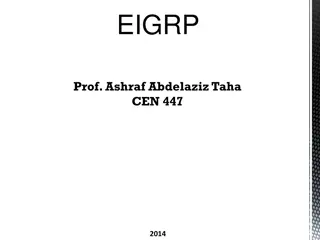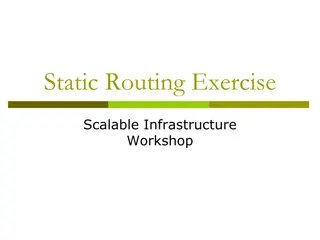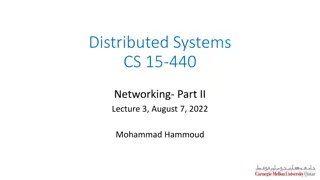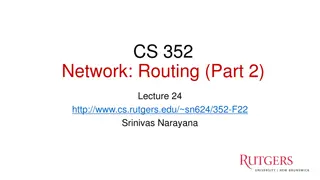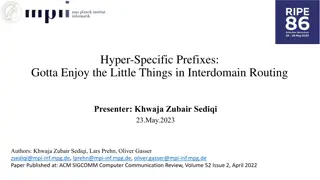Proposed Service Routing and Power Distribution for Modular Systems
This detailed documentation showcases the proposed service routing and power distribution strategies for modular systems, focusing on inclined quads, flat sections, and inclined regions. It includes images illustrating the layout, module flex design, and power routing configurations. The content emphasizes the innovative approaches taken to enhance flexibility, reduce stresses, and optimize power distribution within the system.
Download Presentation

Please find below an Image/Link to download the presentation.
The content on the website is provided AS IS for your information and personal use only. It may not be sold, licensed, or shared on other websites without obtaining consent from the author.If you encounter any issues during the download, it is possible that the publisher has removed the file from their server.
You are allowed to download the files provided on this website for personal or commercial use, subject to the condition that they are used lawfully. All files are the property of their respective owners.
The content on the website is provided AS IS for your information and personal use only. It may not be sold, licensed, or shared on other websites without obtaining consent from the author.
E N D
Presentation Transcript
Layout v142 Layout v136/v142 Number of Modules per row Flat (QUADs) 9 9 9 Links/FE Flat 2 1 1 Layer Number of module rows in Tilted (QUADs) 6 8 9 Tilted 2 1 1 2 3 4 32 44 56 Page 2
Inclined Quads: Proposed Service Routing Cooling pipes & electrical services are routed on the outer surface of the layer shells PST To PP1 To PP1 / L4 L3 EC Services/Pipes Longerons L2 Services/Pipes Inclined Sections Support Half Shells Page 3
Initial Proposal: Flat Section Type-0 routed on top of the longeron 2 x SP chains per detector side (9+9 modules or 10+8) Longeron flexes connect in series modules from two adjacent CLs ( tree concept ) PP0 SP Bias resistors SP 2 SP 1 Z=0 Flex Tree Concept Page 4
Flat Section: Module Flex In Argonne, the Pixel community agreed to work on a single module flex Common flex design with connectors + different pigtails for the various sub-systems Separate connectors for power and data Separate pigtails for power and data at both ends (as in the demonstrator) offer certain mechanical advantages due to additional compliance: Flexibility reduces stresses on the modules (critical to deal with thermo-elastic deformations) Reduce sensitivity to connector absolute positioning Page 5
Inclined Region: Power Routing in Phi To PP1 DCS Back of the Ring Front of the Ring Preferred option from mechanics and integration points of view: 2SP chains per inclined half ring split in Phi=90 Each SP chain combines modules from the front and back side of the ring (equivalent to tree concept in the longeron) In the same SP chain, aggregators can be shared between adjacent modules from the same or opposite sides of the ring Data routed in z, with the aggregators placed near the modules Module PSPP Module Agg PSPP Module PSPP Module SP1 Agg PSPP Module PSPP Module Agg PSPP Module PSPP Module To PP1 Agg PSPP Module PSPP Module Agg PSPP Module PSPP Module Agg PSPP Module SP2 PSPP Module Agg PSPP Module PSPP Module Agg PSPP Power Data To PP1 DCS Page 6
Inclined Section: Corrugated Shells Study possible solution to gain additional radial space to implement powering in phi Corrugated shells to take advantage of the gaps between rings Additional space available for routing of the power services in phi and to hide the aggregator end of the active cable below the level of the shell outer radius Page 7
Inclined Section: Type-1 Power & DCS Routing of the type-1 power cables in phi within the (grooves of the shell) before going out in Z to obtain a homogenous distribution in phi and similar lengths for all the rings Towards PP1 Z=0 Ring 1 Ring 2 Ring 3 Ring 4 Ring 5 Ring 6 Page 8
Flexs design Flat section: Separated data and power flexes in tree Inclined section: power flex in phi, no data flex (virtual PP0 distributed) Power flex containing HV (1 individual line / module ?) VDCS LV & GND SCB (3 diff lines: SCL, SDAm, SDAs) Tlock & Tlock_ret PSPP chip: packaging seems mandatory Connectors PP0: Unimicron ? PP1: Samtec Z-ray (up to 400 pins)




